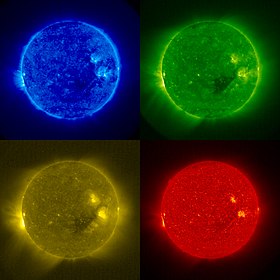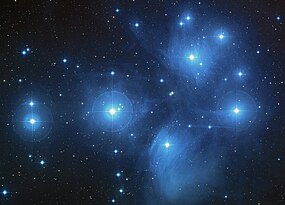Portal:Stars
IntroductionA star is a luminous spheroid of plasma held together by self-gravity. The nearest star to Earth is the Sun. Many other stars are visible to the naked eye at night; their immense distances from Earth make them appear as fixed points of light. The most prominent stars have been categorised into constellations and asterisms, and many of the brightest stars have proper names. Astronomers have assembled star catalogues that identify the known stars and provide standardized stellar designations. The observable universe contains an estimated 1022 to 1024 stars. Only about 4,000 of these stars are visible to the naked eye—all within the Milky Way galaxy. A star's life begins with the gravitational collapse of a gaseous nebula of material largely comprising hydrogen, helium, and trace heavier elements. Its total mass mainly determines its evolution and eventual fate. A star shines for most of its active life due to the thermonuclear fusion of hydrogen into helium in its core. This process releases energy that traverses the star's interior and radiates into outer space. At the end of a star's lifetime as a fusor, its core becomes a stellar remnant: a white dwarf, a neutron star, or—if it is sufficiently massive—a black hole. Stellar nucleosynthesis in stars or their remnants creates almost all naturally occurring chemical elements heavier than lithium. Stellar mass loss or supernova explosions return chemically enriched material to the interstellar medium. These elements are then recycled into new stars. Astronomers can determine stellar properties—including mass, age, metallicity (chemical composition), variability, distance, and motion through space—by carrying out observations of a star's apparent brightness, spectrum, and changes in its position in the sky over time. Stars can form orbital systems with other astronomical objects, as in planetary systems and star systems with two or more stars. When two such stars orbit closely, their gravitational interaction can significantly impact their evolution. Stars can form part of a much larger gravitationally bound structure, such as a star cluster or a galaxy. (Full article...) Selected star - Photo credit: NASA's STEREO
The Sun is the star at the center of the Solar System. The Sun has a diameter of about 1,392,000 kilometers (865,000 mi) (about 109 Earths), and by itself accounts for about 99.86% of the Solar System's mass; the remainder consists of the planets (including Earth), asteroids, meteoroids, comets, and dust in orbit. About three-quarters of the Sun's mass consists of hydrogen, while most of the rest is helium. Less than 2% consists of other elements, including iron, oxygen, carbon, neon, and others. The Sun's color is white, although from the surface of the Earth it may appear yellow because of atmospheric scattering. Its stellar classification, based on spectral class, is G2V, and is informally designated a yellow star, because the majority of its radiation is in the yellow-green portion of the visible spectrum. In this spectral class label, G2 indicates its surface temperature of approximately 5,778 K (5,505 °C), and V (Roman five) indicates that the Sun, like most stars, is a main sequence star, and thus generates its energy by nuclear fusion of hydrogen nuclei into helium. Selected article - Photo credit: NASA, ESA, AURA/Caltech, Palomar Observatory
In astronomy, the Pleiades, or Seven Sisters (Messier object 45), is an open star cluster containing middle-aged hot B-type stars located in the constellation of Taurus. It is among the nearest star clusters to Earth and is the cluster most obvious to the naked eye in the night sky. Pleiades has several meanings in different cultures and traditions. The cluster is dominated by hot blue and extremely luminous stars that have formed within the last 100 million years. Dust that forms a faint reflection nebulosity around the brightest stars was thought at first to be left over from the formation of the cluster (hence the alternate name Maia Nebula after the star Maia), but is now known to be an unrelated dust cloud in the interstellar medium that the stars are currently passing through. Astronomers estimate that the cluster will survive for about another 250 million years, after which it will disperse due to gravitational interactions with its galactic neighborhood. The Pleiades are a prominent sight in winter in the Northern Hemisphere and in summer in the Southern Hemisphere, and have been known since antiquity to cultures all around the world, including the Māori (who call them Matariki) and Australian Aborigines, the Persians (who called them Parveen/parvin and Sorayya), the Chinese, the Maya (who called them Tzab-ek), the Aztec (Tianquiztli), and the Sioux and Cherokee of North America. Selected image - Photo credit: Hubble Space Telescope/NASA and ESA
A planetary nebula is an emission nebula consisting of an expanding glowing shell of ionized gas and plasma ejected during the asymptotic giant branch phase of certain types of stars late in their life. This name originated with their first discovery in the 18th century because of their similarity in appearance to giant planets when viewed through small optical telescopes, and is otherwise unrelated to the planets of the solar system. They are a relatively short-lived phenomenon, lasting a few tens of thousands of years, compared to a typical stellar lifetime of several billion years. Planetary nebulae play a crucial role in the chemical evolution of the galaxy, returning material to the interstellar medium that has been enriched in heavy elements and other products of nucleosynthesis. Did you know?
SubcategoriesTo display all subcategories click on the ►
Selected biography - Photo credit: Portrait from Toruń
Nicolaus Copernicus (19 February 1473 – 24 May 1543) was the first astronomer to formulate a comprehensive heliocentric cosmology, which displaced the Earth from the center of the universe. Nicolaus Copernicus was born on 19 February 1473 in the city of Toruń (Thorn) in Royal Prussia, part of the Kingdom of Poland. Copernicus' epochal book, De revolutionibus orbium coelestium (On the Revolutions of the Celestial Spheres), published just before his death in 1543, is often regarded as the starting point of modern astronomy and the defining epiphany that began the scientific revolution. His heliocentric model, with the Sun at the center of the universe, demonstrated that the observed motions of celestial objects can be explained without putting Earth at rest in the center of the universe. His work stimulated further scientific investigations, becoming a landmark in the history of science that is often referred to as the Copernican Revolution. Among the great polymaths of the Renaissance, Copernicus was a mathematician, astronomer, physician, quadrilingual polyglot, classical scholar, translator, artist, Catholic cleric, jurist, governor, military leader, diplomat and economist. Among his many responsibilities, astronomy figured as little more than an avocation – yet it was in that field that he made his mark upon the world.
TopicsThings to do
Related portalsAssociated WikimediaThe following Wikimedia Foundation sister projects provide more on this subject:
Discover Wikipedia using portals |
- Portals with triaged subpages from June 2018
- All portals with triaged subpages
- All portals
- Portals with no named maintainer
- Random portal component with 11–15 available subpages
- Random portal component with more available subpages than specified max
- Random portal component with 21–25 available subpages
- Random portal component with fewer available subpages than specified max
- Random portal component with 16–20 available image subpages
- Random portal component with 6–10 available subpages
- Stars
- Astronomy portals
- Physical science portals

























